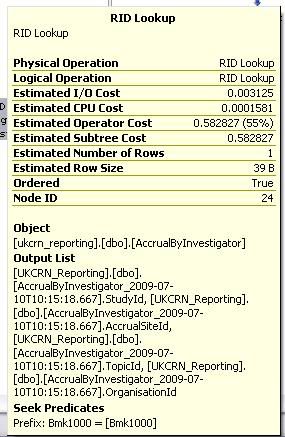Hi all - I am looking into a poorly performing stored procedure and found a RID lookup taking up %55 of the process. I am having problems however translating this back to the code in the procedure which is performing badly. I have attached a picture of the RID properties and also the code is below.If anyone can help me understand how to identify the badly written code I would be grateful.Thanks
SELECT [S].[Acronym] AS StudyAcronym , [O].[Name] AS OrganisationName , ( CASE WHEN [I].[LastName] IS NULL THEN [I].[FirstName] WHEN [I].[FirstName] IS NULL THEN [I].[LastName] ELSE [I].[LastName] + ', ' + [I].[FirstName] END ) AS InvestigatorName , [AcS].[SiteName] AS AccrualSiteName , [m].[StudyEntryYear] , [m].[StudyEntryMonth] , ISNULL([AccrualFigures].[Accrual], 0) AS Accrual FROM ( -- This subquery gets details of all investigators to feature in this report, irrespective of whether they have any accrual for the chosen year. SELECT DISTINCT [ABI].[StudyId] , [ABI].[InvestigatorId] , [ABI].[AccrualSiteId] , [ABI].[OrganisationId] FROM ukcrn_reporting.dbo.AccrualByInvestigator ABI INNER JOIN @studyInvestigators SI ON ( [ABI].[StudyId] = [SI].[StudyId] AND [ABI].[InvestigatorId] = [SI].[InvestigatorId] AND [ABI].[AccrualSiteId] = [SI].[AccrualSiteID] ) INNER JOIN @Studies S ON [ABI].[StudyId] = [S].[StudyId] INNER JOIN @Lrns L ON [ABI].[OrganisationId] = [L].[LrnId] WHERE [ABI].[TopicId] = @topicId OR @topicID = -1 ) AllInvestigators CROSS JOIN @months m LEFT OUTER JOIN ( -- This subquery gets details of investigators who have actually recruited during the year SELECT [ABI].[StudyId] , [ABI].[InvestigatorId] , [ABI].[AccrualSiteId] , [ABI].[OrganisationId] , DATEPART(yy, [ABI].[StudyEntryDate]) StudyEntryYear , DATEPART(mm, [ABI].[StudyEntryDate]) StudyEntryMonth , COUNT(*) AS Accrual FROM ukcrn_reporting.dbo.AccrualByInvestigator ABI INNER JOIN @Studies S ON [ABI].[StudyId] = [S].[StudyId] INNER JOIN @lrns L ON [ABI].[OrganisationId] = [L].[LrnId] INNER JOIN @studyInvestigators SI ON ( [ABI].[StudyId] = [SI].[StudyId] AND [ABI].[InvestigatorId] = [SI].[InvestigatorId] AND [ABI].[AccrualSiteId] = [SI].[AccrualSiteID] ) INNER JOIN @recruitTypes RT ON [ABI].[RecruitType] = [RT].[RecruitTypeId] WHERE [ABI].[StudyEntryDate] BETWEEN @DateFrom AND @DateTo AND ( [ABI].[TopicId] = @TopicID OR @TopicID = -1 ) GROUP BY [ABI].[StudyId] , [ABI].[InvestigatorId] , [ABI].[AccrualSiteId] , [ABI].[OrganisationId] , DATEPART(yy, [ABI].[StudyEntryDate]) , DATEPART(mm, [ABI].[StudyEntryDate]) ) AccrualFigures ON ( [AllInvestigators].[StudyId] = [AccrualFigures].[StudyId] AND [AllInvestigators].[InvestigatorId] = [AccrualFigures].[InvestigatorId] AND [AllInvestigators].[AccrualSiteId] = [AccrualFigures].[AccrualSiteId] AND [AllInvestigators].[OrganisationId] = [AccrualFigures].[OrganisationId] AND [m].[StudyEntryYear] = [AccrualFigures].[StudyEntryYear] AND [m].[StudyEntryMonth] = [AccrualFigures].[StudyEntryMonth] ) INNER JOIN [dbo].[Study] S ON [AllInvestigators].[StudyId] = [S].[Id] INNER JOIN [dbo].[Investigator] I ON [AllInvestigators].[InvestigatorId] = [I].[Id] INNER JOIN [dbo].[Organisation] O ON [AllInvestigators].[OrganisationId] = [O].[Id] INNER JOIN [dbo].[AccrualSite] AcS ON [AllInvestigators].[AccrualSiteId] = [AcS].[Id] ORDER BY [S].[Acronym] , [O].[Name] , [AcS].[SiteName]

